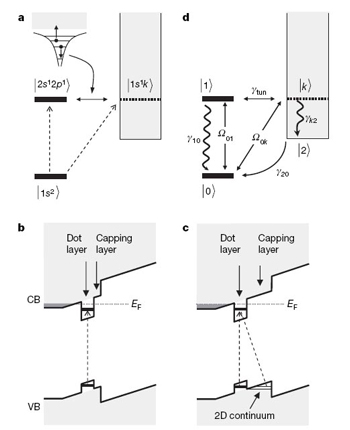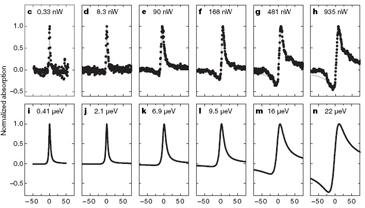
| Home | About Us | Contribute | Bookstore | Advertising | Subscribe for Free NOW! |
| News Archive | Features | Events | Recruitment | Directory |
CMP PROCESSING
Learn more about R&D chemical mechanical polishing by requesting our FREE informational CD.
| FREE subscription |
| Subscribe for free to receive each issue of Semiconductor Today magazine and weekly news brief. |
News
24 January 2008
Nonlinear Fano effect tracks down weak quantum dot couplings
Scientists from Germany, the USA and UK have developed a new technique on a quantum dot (QD) system that could probe weak couplings between excited and continuum states (Kroner et al, Nature, p.311, 17 January 2008). The technique is based on an analysis of optical absorption by means of a nonlinear Fano effect.
Couplings to continuum states are not usually a good thing for QD system applications. A probe that allows more precise determination of such couplings could be used to investigate ways to eliminate them.
The ‘Fano effect’ refers to a model of optical absorption where a two-state system also has a weak coupling from the excited state to a continuum of states. Optical stimulation with laser light raises the system from the ground state to the continuum states through two quantum ‘paths’ (i.e. they interfere, so one cannot really say that the system has been excited in one way or the other). One path is direct excitation (from the ground state to the continuum); the other involves coupling between the excited state and the continuum. The latter, mediated path (ground state-excited state-continuum) introduces an asymmetry resulting from the perturbation theory (energy denominator) term changing sign as the photon energy passes through the energy of the excited state.
The researchers set up two quantum dot systems. The first, serving as a control, contained a layer of InGaAs QDs separated from a GaAs electron reservoir by a 25nm barrier and from a AlAs/GaAs superlattice blocking barrier by a 10nm capping layer (see energy level diagram in Figure 1b) . For the second system, the capping layer is extended to 30nm to allow a continuum of two-dimensional (2D) hole states to be created with the application of an electric field (Figure 1c). The ground state consists of an electron in the valence band, and the discrete excited state contains an exciton (consisting of two electrons and a hole). The optical laser absorption experiments were carried out at 4.2K around the energy of the exciton transition.

Figure 1. Energy-level diagrams: (a) original Fano system describing helium; (b) sample 1 (control); (c) sample 2 with continuum states; (d) energy levels, transitions and relaxation processes of theoretical model.
The paper comments: “Our key result is that the Fano effects become more and more pronounced as the laser power increases, starting out very small at low power in the linear regime but becoming unmistakable at high power in the nonlinear regime.”
As seen in figure 2, the absorption spectrum at low power is a peak, while at high laser powers it becomes kinked, showing the Fano effects. The boosting of the Fano effects results from the discrete-continuum transition (containing direct and mediated terms) responding to the power of the laser differently compared to the discrete-discrete absorption of the exciton state. The discrete-discrete process has a symmetric (Lorentzian, not Gaussian) bell shape absorption spectrum. The optical transition between the discrete levels saturates, becoming broader, while the continuum transition does not in the power range of the experiment. “Increasing the laser power eventually enhances the continuum transition rate to match the saturated discrete level transition,” say the researchers.

Figure 2. How the Fano structure develops with increasing laser power: (c)-(h) show experimental results; (i)-(n) the theoretical model. The y-axis shows the change in transmission, normalized by the transmission, as a function of the detuning of the laser probe from the exciton level.
Theoretical physicist Sasha Govorov of Ohio University, a co-author on the paper, developed the theory side of the experiment, which was performed at the Ludwig-Maximilians University in Munich, Germany.
“Our theory suggests that the nonlinear Fano effect and the method associated with it can potentially be applied to a variety of physical systems to reveal weak interactions,” Govorov said.
The experimenters believe that older experiments on atoms can be revisited using strong, coherent light sources to reveal other nonlinear Fano effects. For example, ‘the’ nonlinear Fano effect of Rzazewski and Eberly [Phys. Rev. Lett. Vol. 47, p. 408, 1981] has not been realized as yet.
Visit: www.nature.com
The author Mike Cooke is a freelance technology journalist who has worked in the semiconductor and advanced technology sectors since 1997.
